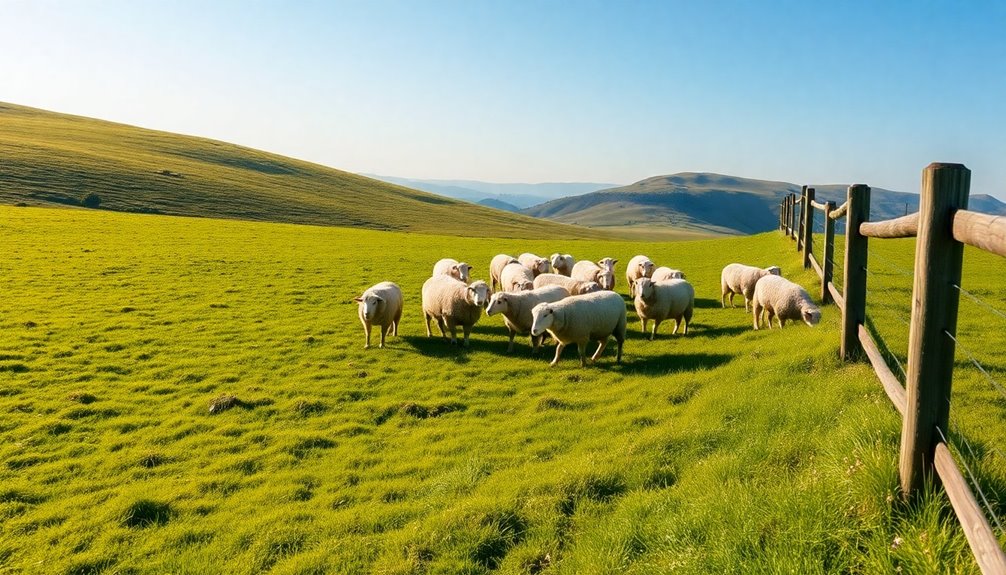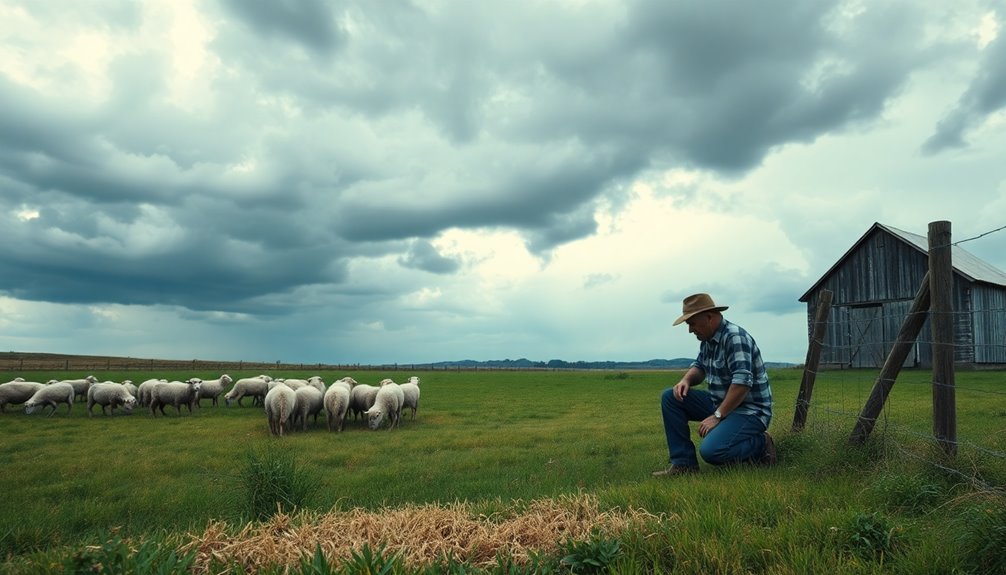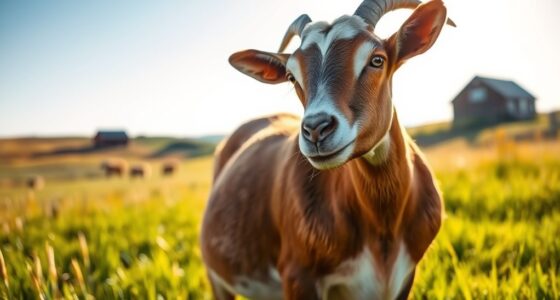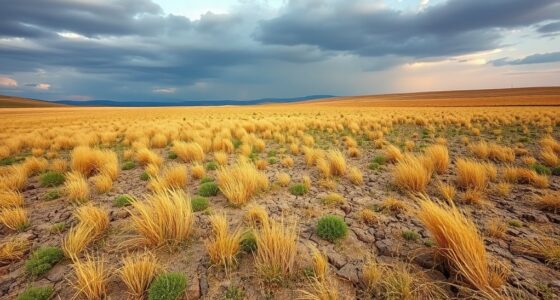To guarantee your sheep flock is healthy and your pastures are productive, focus on balanced nutrition, effective pasture management, and proactive health strategies. Provide high-quality forages like alfalfa and maintain access to clean water and minerals. Rotate your sheep every 3-5 days to prevent overgrazing and encourage pasture regrowth. Monitor flock health regularly and apply necessary vaccinations. Implementing a rotational grazing system enhances pasture quality and flock productivity. By following these best practices, you'll see improvements in both animal health and pasture sustainability. There's much more to explore that can help optimize your grazing approach.
Key Takeaways
- Implement Managed Intensive Grazing (MIG) by rotating sheep every 3-5 days to enhance pasture health and prevent overgrazing.
- Maintain optimal grass height by grazing down to 2-3 inches while allowing a rest period of at least 29 days.
- Ensure a balanced diet with high-quality forages and monitor body condition for timely nutritional adjustments.
- Regularly assess flock health through behavior monitoring and vaccinations to prevent disease outbreaks.
- Utilize diverse forages, including clover, to improve nutrition and promote nitrogen fixation in pastures.
Nutritional Guidelines for Ewes

When it comes to feeding ewes, a balanced diet is critical for their health and productivity. Ewes have specific nutritional needs that vary throughout their life stages, particularly during breeding and nursing.
To support their health, provide high-quality forages, such as alfalfa and grass species, along with commercial feeds as necessary. Flushing, or adding extra feed two weeks before breeding, can enhance protein content and boost the chances of ewes having twins.
During the nursing period, especially for those with twins, ewes need increased energy and protein, so consider high-quality legume hay and grain supplements.
Don't forget to verify they've access to clean water and loose trace mineral salt to maintain peak health and productivity.
Replacement Ewes and Lambs
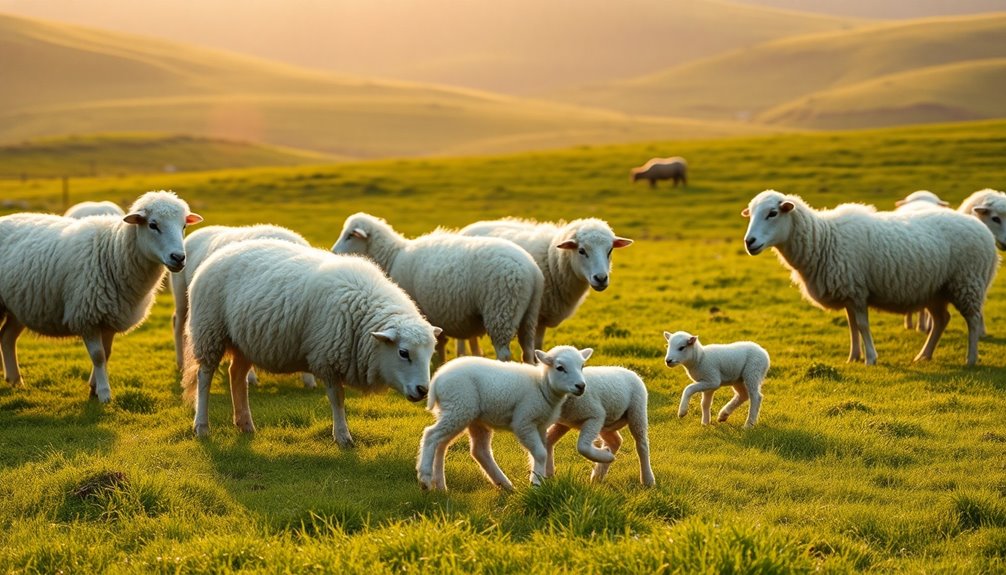
Replacement ewes and lambs are essential to maintaining a productive flock, so ensuring they receive proper nutrition is vital for their growth and future breeding performance.
Focus on meeting their feed requirements by providing high-quality forage during their growth phase. Replacement ewes should gain about 4 lbs per day, so consider a diet that incorporates pasture, alfalfa, or mixed hay, supplemented with 18% commercial feed.
For replacement lambs, aim for a weight gain of 6 lbs per day using pasture combined with corn or alfalfa hay and commercial feed. Regularly monitor their body condition to adjust rations as needed.
Implementing a rotational grazing system can improve pasture quality, supporting the nutritional needs of your breeding stock and overall flock health.
Pasture Management Techniques
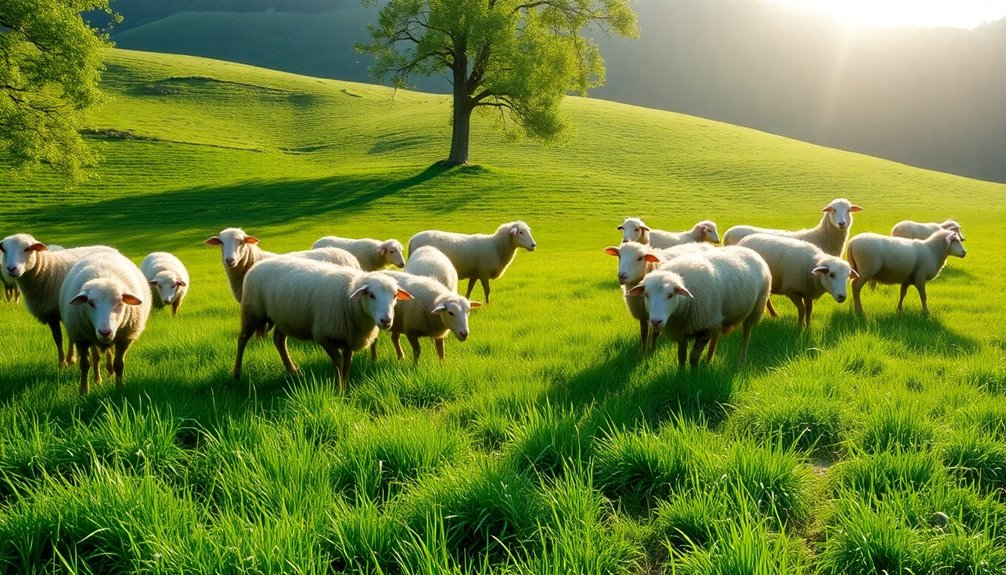
Effective pasture management techniques are essential for maintaining healthy grazing conditions for your sheep. Implement Managed Intensive Grazing (MIG) by rotating your sheep every 3-5 days through small paddocks, allowing ideal regrowth and preventing overgrazing. Aim for a rest period of at least 29 days between grazing cycles. Monitor your pastures to guarantee the grass reaches 9 inches and is grazed down to 2-3 inches. Maintain a stocking density of about 10 sheep per acre, adjusting based on conditions. Utilize diverse forages, including 50-70% red and white clover, to enhance nutrition and support nitrogen fixation. Finally, guarantee effective parasite control by allowing sufficient rest periods, disrupting parasite life cycles.
| Technique | Benefits | Key Considerations |
|---|---|---|
| Managed Intensive Grazing | Ideal regrowth | 3-5 day rotations |
| Diverse Forage Options | Enhanced nutrition | 50-70% clover content |
| Regular Monitoring | Prevents soil degradation | Grass height management |
Health Management Strategies
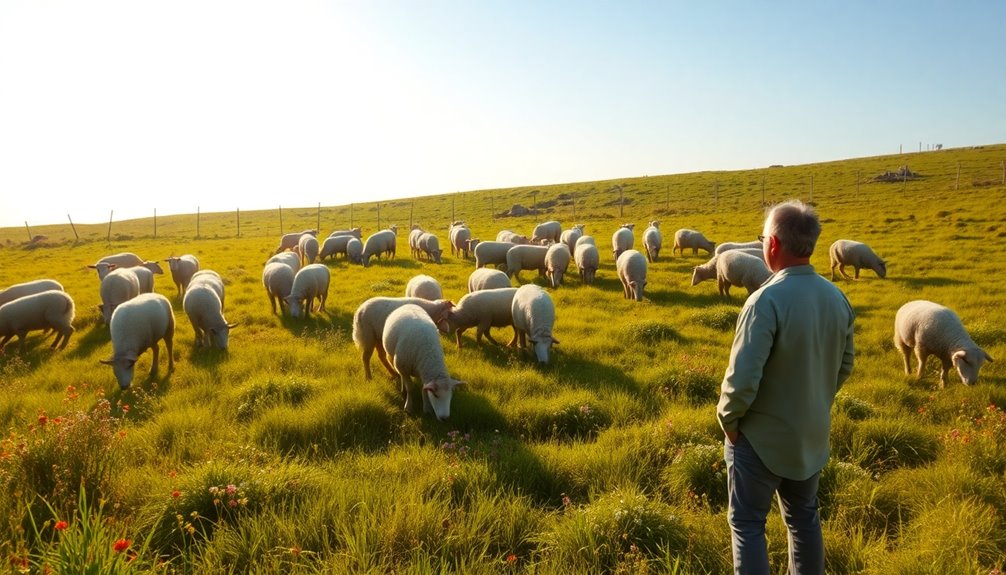
Maintaining healthy grazing conditions isn't just about pasture management; sheep health is equally important for a thriving flock.
To guarantee your sheep remain healthy, regularly monitor their behavior for signs of distress like limping or lack of feeding. Implement a vaccination program, including CD-T vaccines for lambs and ewes, to protect against clostridial diseases.
Use FAMACHA checks to assess anemia levels, allowing you to deworm strategically based on individual needs to manage parasites effectively. Quarantine new animals for at least three weeks to prevent disease introduction and maintain strict biosecurity measures, such as foot baths for visitors.
Additionally, participate in the National Scrapie Eradication Program to safeguard the overall health and safety of your flock.
Rotational Grazing Benefits
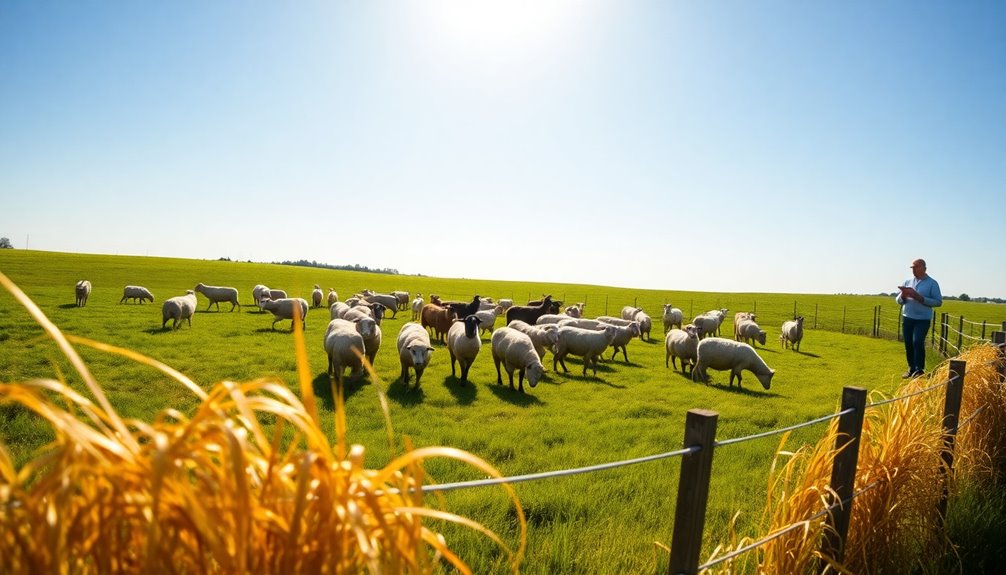
Implementing rotational grazing can greatly enhance the health of both your pasture and flock. By optimizing grazing periods, you prevent overgrazing and support essential rest and regrowth for your grasses. This method not only boosts pasture health but also helps in maintaining soil fertility.
Consider these benefits:
- Reduced parasite buildup through strategic movement of sheep, disrupting life cycles.
- Increased forage diversity, ensuring your flock receives balanced nutrition.
- Improved flock productivity as healthier pastures lead to better livestock performance.
With short grazing cycles of 1-3 days, you promote even grazing, exercise for your sheep, and a sustainable food source.
Adopting rotational grazing practices will lead to thriving pastures and healthier animals, enhancing your overall farming success.
Frequently Asked Questions
How Many Hours a Day Should Sheep Graze?
When it comes to how many hours a day sheep should graze, aim for around 8 to 12 hours.
This varies based on the quality of the pasture and the availability of forage. You can adjust their grazing times depending on the growth stage of the grass.
Monitoring pasture conditions regularly helps you determine the best grazing hours, ensuring your sheep get the nutrition they need while preventing overgrazing.
What Is Intensive Grazing Management for Sheep?
Intensive Grazing Management (IGM) for sheep focuses on rotating your flock through small paddocks, typically moving them every 3-5 days.
This method allows for short grazing periods that promote pasture regrowth while preventing overgrazing. By maintaining grass height at 2-3 inches post-grazing, you can increase pasture yield considerably.
Additionally, IGM helps reduce parasite loads and promotes healthier livestock, making it a practical approach for sustainable sheep farming.
What Are the Best Management Practices for Sheep?
To manage your sheep effectively, focus on balanced nutrition, regular health checks, and pasture management.
Guarantee your flock has access to high-fiber forages, fresh water, and minerals. Monitor their health daily and implement a vaccination schedule.
Rotate grazing areas to prevent overgrazing and manage parasites. Keep an eye on pasture conditions to adjust stocking density as needed.
Prioritizing these practices will lead to healthier sheep and more productive grazing outcomes.
What Are the Disadvantages of Sheep Grazing?
Imagine a lush pasture, vibrant with green grasses and wildflowers.
Now picture it barren, overgrazed, and lifeless. That's one disadvantage of sheep grazing. It can lead to soil degradation and reduced plant recovery.
You might face nutritional imbalances, forcing you to spend more on feed.
Plus, continuous grazing increases parasite risks, jeopardizing flock health.
Finally, selective grazing diminishes forage diversity, allowing undesirable plants to thrive while your pasture struggles to regenerate.
Conclusion
As you tend to your flock, think of each ewe as a thread in a vibrant tapestry. Nurture them with proper nutrition and care, like a gardener feeding their blooms. Embrace rotational grazing, for it's the dance of seasons that brings life to your pastures. By weaving together health management and pasture techniques, you're not just raising sheep; you're cultivating a thriving ecosystem. In this harmonious balance, both your flock and land will flourish together, creating a legacy of abundance.

